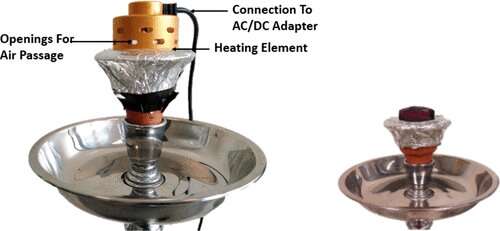Electric hookahs might be no safer than traditional charcoal-based ones

Waterpipe tobacco smoking, otherwise known as "hookah" or "shisha," is becoming increasingly popular worldwide, especially among youth. Traditional hookahs burn charcoal as a heat source, but recently, electrical heating elements (EHEs) have been introduced to the market. Reinforced by product advertising and package labeling, many hookah smokers believe that EHEs are less harmful than charcoal. Now, researchers report in ACS' Chemical Research in Toxicology that although EHEs reduce some toxicants, they increase others.
In traditional hookahs, smokers burn charcoal on top of a tobacco preparation known as ma'ssel, a mixture of tobacco, glycerin, water and flavorings. The resulting smoke bubbles through water at the bottom of the pipe before being inhaled through a tube by the smoker. Previous studies have shown that charcoal contributes most of the harmful polycyclic aromatic hydrocarbons (PAHs) and carbon monoxide found in hookah smoke. Therefore, manufacturers have developed EHEs for hookahs, in some cases advertising them as "toxicant-free" or "carbon monoxide-free." Alan Shihadeh and colleagues at the American University of Beirut wanted to investigate these claims by comparing the emissions of several major toxicants from waterpipes using EHEs or charcoal.
With an automatic smoking machine, the researchers examined emissions from a hookah using charcoal or one of three commercially available EHEs as the heat source. They found that the EHEs reduced carbon monoxide and PAH emissions by 90% and 80%, respectively. However, emissions of acrolein, a highly reactive irritant thought to be responsible for nearly all non-cancer respiratory diseases in cigarette smokers, was several orders of magnitude higher with EHE use, compared with charcoal use. In addition, levels of some other volatile aldehydes were higher in EHE-produced smoke than in charcoal-produced smoke. Aerosolized particulate matter and nicotine yield were similar among the heating sources. These results suggest that marketing EHEs as safer than charcoal might be misleading, the researchers say.
More information: Mario El Hourani et al. Comparison of CO, PAH, Nicotine, and Aldehyde Emissions in Waterpipe Tobacco Smoke Generated Using Electrical and Charcoal Heating Methods, Chemical Research in Toxicology (2019). DOI: 10.1021/acs.chemrestox.9b00045
Journal information: Chemical Research in Toxicology
Provided by American Chemical Society





















